PA5-47039
antibody from Invitrogen Antibodies
Targeting: IL1RAPL2
IL-1R9, IL1R9, IL1RAPL-2, TIGIRR-1
Antibody data
- Antibody Data
- Antigen structure
- References [1]
- Comments [0]
- Validations
- Flow cytometry [4]
- Other assay [1]
Submit
Validation data
Reference
Comment
Report error
- Product number
- PA5-47039 - Provider product page

- Provider
- Invitrogen Antibodies
- Product name
- IL1RAPL2 Polyclonal Antibody
- Antibody type
- Polyclonal
- Antigen
- Recombinant full-length protein
- Description
- In direct ELISAs, approximately 35% cross-reactivity with recombinant mouse IL-1 RAPL2/IL-1 R9 is observed. In Western blots, approximately 5% cross-reactivity with recombinant human (rh) IL-1 R7 is observed and less than 1% cross-reactivity with rhIL-1 R2 and rhIL-1 R8 is observed. Reconstitute at 0.2 mg/mL in sterile PBS.
- Reactivity
- Human
- Host
- Goat
- Isotype
- IgG
- Vial size
- 100 μg
- Concentration
- 0.2 mg/mL
- Storage
- -20°C, Avoid Freeze/Thaw Cycles
Submitted references Gene-expression correlates of the oscillatory signatures supporting human episodic memory encoding.
Berto S, Fontenot MR, Seger S, Ayhan F, Caglayan E, Kulkarni A, Douglas C, Tamminga CA, Lega BC, Konopka G
Nature neuroscience 2021 Apr;24(4):554-564
Nature neuroscience 2021 Apr;24(4):554-564
No comments: Submit comment
Supportive validation
- Submitted by
- Invitrogen Antibodies (provider)
- Main image
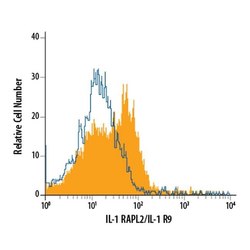
- Experimental details
- Flow cytometric analysis of HepG2 human hepatocellular carcinoma cell line was stained with Goat Anti-human IL-1 RAPL2/IL-1 R9 Antigen Affinity-purified Polyclonal Antibody (Product # PA5-47039, filled histogram) or control antibody (open histogram), followed by Allophycocyanin-conjugated Anti-Goat IgG Secondary Antibody.
- Submitted by
- Invitrogen Antibodies (provider)
- Main image
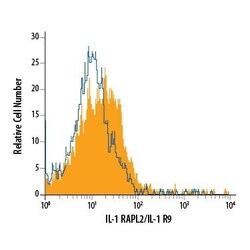
- Experimental details
- Flow cytometry of IL1RAPL2 in Hepa 1‚6 mouse hepatoma cell line. Samples were incubated in IL1RAPL2 polyclonal antibody (Product # PA5-47039) or control antibody followed by Allophycocyanin-conjugated Anti-Goat IgG Secondary Antibody.
- Submitted by
- Invitrogen Antibodies (provider)
- Main image
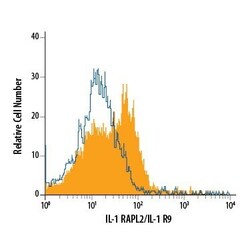
- Experimental details
- Flow cytometry of IL1RAPL2 in HepG2 human hepatocellular carcinoma cell line. Samples were incubated in IL1RAPL2 polyclonal antibody (Product # PA5-47039) or control antibody followed by Allophycocyanin-conjugated Anti-Goat IgG Secondary Antibody.
- Submitted by
- Invitrogen Antibodies (provider)
- Main image
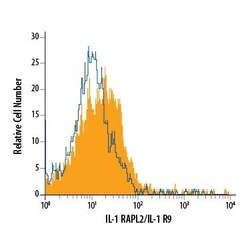
- Experimental details
- Flow cytometry of IL1RAPL2 in Hepa 1‚6 mouse hepatoma cell line. Samples were incubated in IL1RAPL2 polyclonal antibody (Product # PA5-47039) or control antibody followed by Allophycocyanin-conjugated Anti-Goat IgG Secondary Antibody.
Supportive validation
- Submitted by
- Invitrogen Antibodies (provider)
- Main image
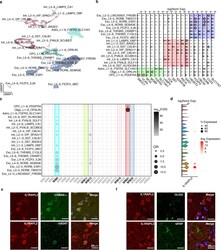
- Experimental details
- Fig. 5: SME-specific modules are enriched for excitatory and inhibitory neurons. a, Uniform manifold approximation and projection (UMAP) representation of the 20 classes of cell-types using the BA38 snRNA-seq. Each dot represents a nucleus. Excitatory neurons are highlighted in blue gradient, the inhibitory neurons in red gradient, and the non-neuronal cells in light blue gradient. Cell-types were annotated using a publicly available single cell data. A Fisher's exact enrichment test between cell markers of the two datasets was performed. Major cell types tend to cluster near one another. b, Violin-plots representing gene markers for the major cell-types detected. Y-axis represents the log normalized expression (log(Norm Exp)) of each marker gene in each cluster. The markers for excitatory neurons (e.g. CUX, RORB ) are highlighted in blue. The markers for inhibitory neurons (e.g. GAD1, RELN ) are highlighted in red. The markers for non-neuronal cells (e.g. FGFR3, MOBP, VCAN ) are highlighted in green. c, Bubble-chart showing the enrichment of the SME modules for cell-type markers defined by Seurat. Color gradient represents the -log 10 (FDR) and bubble size represent the odds ratio (OR) from a Fisher's exact enrichment test of genes in modules from this study with genes expressed in specific cell types defined by our snRNA-seq data. X-axis represents the SME-specific modules. Y-axis represents the cell classes of the present study. Boldface type indicates the six modules sign
 Explore
Explore Validate
Validate Learn
Learn Western blot
Western blot Immunohistochemistry
Immunohistochemistry Flow cytometry
Flow cytometry